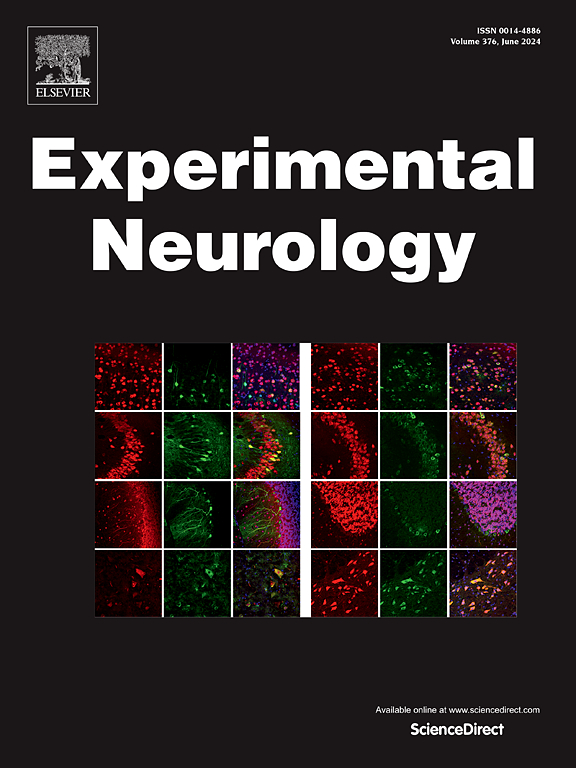比较脂质分析揭示了不同脂质亚类在爆炸和钝性轻度创伤性脑损伤中的差异反应。
IF 4.6
2区 医学
Q1 NEUROSCIENCES
引用次数: 0
摘要
爆炸造成的头部创伤是一个日益严重的健康问题,特别是在现役军事人员中,被认为是海湾战争的标志性伤害。然而,爆炸相关的创伤性脑损伤(TBI)与创伤性脑损伤(TBI)之间是否存在其他机制的根本差异仍然是未知的。考虑到脑外伤中脂质代谢与神经元膜完整性及其损害相关的重要性,我们试图发现爆炸或钝性(Stereotaxically Controlled挫伤- scc)介导的脑外伤中脂质组学谱的变化。在本研究中,我们在C57BL/6小鼠身上建立了爆炸(130 ± 10 kPa)和SCC(1.5 mm背腹侧)轻度TBI (mTBI)模型,并在第1天和第7天采集血清。脂质代谢组学通过超高效液相色谱(UHPLC)四极杆飞行时间质谱(qTOF-MS)进行。此外,使用修订后的小鼠神经行为严重程度评分(mNSS-R)和开放场测试(OFT)估计神经行为结果。研究发现,爆炸暴露组表现出更多的脂质失调,在两个时间点都有更多的显著脂质和相关途径。然而,对比研究进一步揭示了八种显著的常见脂质,无论诱导方式如何(爆炸或钝性),它们都可以表征mTBI。此外,观察mtbi后神经行为、运动和焦虑功能的调节。该研究阐明了mtbi后不同的系统性脂质代谢旨在保持大脑的脂质稳态。这种方法可能为脂质代谢和单个脂质种类的鉴定提供新的见解,有助于理解mTBI的病理生理。本文章由计算机程序翻译,如有差异,请以英文原文为准。

Comparative lipid profiling reveals the differential response of distinct lipid subclasses in blast and blunt-induced mild traumatic brain injury
Head trauma from blast exposure is a growing health concern, particularly among active military personnel, and is considered the signature injury of the Gulf War. However, it remains elusive whether fundamental differences exist between blast-related Traumatic Brain Injuries (TBI) and TBI due to other mechanisms. Considering the importance of lipid metabolism associated with neuronal membrane integrity and its compromise during TBI, we sought to find changes in lipidomic profiling during blast or blunt (Stereotaxically Controlled Contusison-SCC)-mediated TBI. In the current study, we have developed the mild TBI (mTBI) model of blast (130 ± 10 kPa) and SCC (1.5 mm dorsal-ventral) on C57BL/6 mice, followed by the serum collection on days 1 and 7. Lipidomics was performed via ultra-high performance liquid chromatography (UHPLC) quadrupole time-of-flight mass spectrometry (qTOF-MS). Additionally, neurobehavioral outcomes were estimated using a revised neurobehavioral severity score for mice (mNSS-R) and an open field test (OFT). The study found that blast-exposed group exhibited more lipid dysregulation, as evidenced by a higher number of significant lipids and associated pathways at both time points. However, the comparative investigation further reveals eight significantly common lipids that can characterize the mTBI regardless of the manner of induction (blast or blunt). Besides, modulated neurobehavioral, locomotor and anxiety functions were also observed post-mTBI. The study illustrates the distinct systemic lipid metabolism intended to preserve the brain's lipid homeostasis post-mTBI. This approach may provide novel insights into lipid metabolism and identification of individual lipid species that aids in understanding the pathophysiology of mTBI.
求助全文
通过发布文献求助,成功后即可免费获取论文全文。
去求助
来源期刊

Experimental Neurology
医学-神经科学
CiteScore
10.10
自引率
3.80%
发文量
258
审稿时长
42 days
期刊介绍:
Experimental Neurology, a Journal of Neuroscience Research, publishes original research in neuroscience with a particular emphasis on novel findings in neural development, regeneration, plasticity and transplantation. The journal has focused on research concerning basic mechanisms underlying neurological disorders.
 求助内容:
求助内容: 应助结果提醒方式:
应助结果提醒方式:


